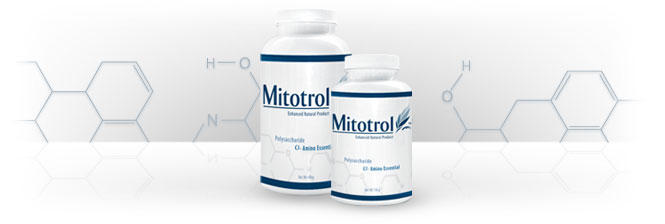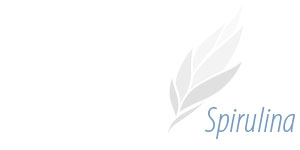Mitotrol
The Science behind the ingredients

Mitotrol contains three elements that give it nutritional power: polysaccharides, peptides, and spirulina blue-green algae. In order to understand the power and efficacy of Mitotrol, it is essential to understand the properties of each of its components.


Is a blue-green algae that’s part of the common, traditional diet in certain areas of Mexico and countries in Africa. It is among the oldes forms of life on the planet, in alkaline volcano lakes for around 3,500 million years.
Spirulina contains a significant amount of various proteins, which are easily absorbed by the body. These include:
- Essential amino acids (those our body cannot produce on its own)
- Vitamins
- Minerals
- Beta-carotene
- Polysaccharides
- Glucolipids and essential fatty acids
Scientific studies report that:
- Spirulina extract has the ability to increase the activity of the immune system and has anti-viral and cancerogenic properties.
- Consuming spirulina has been linked to decreases in the levels of cholesterol.
- The human consumption of spirulina significantly reduces the concentrations of triacylglycerol and colesterol in the bloodstream, and also reduces bloodpressure.
- Taking spirulina reduces the levels of glucose, cholesterol and triglycerides in the blood of patients with type 2 diabetes (Parikh et al, 2001.)
- Spirulina can make the immune system stronger. A Japanese research team administered spirulina extract to a group of humans over the course of two months. They measured various parameters of immune system activity before and after the spirulina was administered. They found that, in 50% of the volunteers, the isolated NK blood cells (a type of cellular immune system that eliminates cells infected by viruses, and others with tumors) were showing more activity.
- Including spirulina in a chicken´s daily diet increased the production capacity of antibodies, and of NK cell activity.
- Some compounds found in spirulina have antiviral abilities. For example, the in vitro application of Spirulina maxima blocked the infection caused by viruses such as herpes simplex, pseudorabies, and human cytomegalovirus (HCMV.)
- Aqueous Spirulina platensis extract, (also known as Arthrospira platensis), inhibits 50% of the replication of the HIV/AIDS virus-1 in lines of human lymphocytes.
- Phycocyanin C, a component found in spirulina, induces death in a cellular line of leukemia. Also, calcio-spirulina, a component found in spirulina, inhibits the tumor invasion of cellular lines of melanoma, carcinoma of the colon as well as fibrosarcoma. It considerably reduces the metastasis of a cellular line in the lungs as well.
- The consumption of spirulina maxima can protect mice against the neuro-toxic effects of MPTP (a drug used to induce a rodent version of Parkinson´s disease.) Researchers found that mice that had consumed spirulina over 14 days showed a considerable reduction in the MPTP effect. This may be due to the antioxidants contained in spirulina.
REFERENCES:
-Al-Batshan, H. A., Al-Mufarrej, S. I., Al-Homaidan, A. A., Qureshi, M. A. (2001) Enhancement of chicken macrophage phagocytic function and nitrite production by dietary Spirulina platensis. Immunopharmacol Immunotoxicol. 23(2):281-289.
-Alberts, B., Bray, D., Lewis, J., Raff, M., Roberts, K., Watson, J. D. (1994) Molecular biology of the cell. Third edition. pp 1164. New York. Garland Publishing, Inc.
-Ayehunie, S., Belay, A., Baba, T. W., Ruprecht, R. M. (1998) Inhibition of HIV-1 replication by an aqueous extract of Spirulina platensis (Arthrospira platensis). J Acquir Immune Defic Syndr Hum Retrovirol. 1;18(1):7-12.
-Chamorro, G., Pérez-Albiter, M., Serrano-García, N., Mares-Sámano, J. J., Rojas, P. (2007) Spirulina maxima pretreatment partially protects against 1-methyl-4-phenyl-1,2,3,6-tetrahydropyridine neurotoxicity. Nutritional Neuroscience. 9(5/6): 207–212.
-Hernández-Corona, A., Nieves, I., Meckes, M., Chamorro, G., Barron, B. L. (2002) Antiviral activity of Spirulina maxima against herpes simplex virus type 2. Antiviral Res. 56(3):279-285.
-Hirahashi, T., Matsumoto, M., Hazeki, K., Saeki, Y., Ui, M., Seya, T. (2002) Activation of the human innate immune system by Spirulina: augmentation of interferon production and NK cytotoxicity by oral administration of hot water extract of Spirulina platensis. Int Immunopharmacol. 2(4):423-434.
-Khan, Z., Bhado, P., Bisen, P. S. (2005) Nutritional and Therapeutic Potential of Spirulina. Current Pharmaceutical Biotechnology. 6:373-379.
-Kim, H. M., Lee, E. H., Cho, H. H., Moon, Y. H. (1998) Inhibitory effect of mast cell-mediated immediate-type allergic reactions in rats by spirulina. Biochem Pharmacol. 55(7):1071-1076.
- Mishima, T., Murata, J., Toyoshima, M., Fujii, H., Nakajima, M., Hayashi T., Kato, T., Saiki, I. (1998) Inhibition of tumor invasion and metastasis by calcium spirulan (Ca-SP), a novel sulfated polysaccharide derived from a blue-green alga, Spirulina platensis. Clin Exp Metastasis. 16(6):541-550.
-Parikh, P., Many, U., Iyer, U. (2001) Role of Spirulina in the Control of Glycemia and Lipidemia in Type 2 Diabetes Mellitus. J Med Food. 4(4):193-199.
-Qureshi, M. A., Ali, R. A. (1996a) Spirulina platensis exposure enhances macrophage phagocytic function in cats. Immunopharmacol Immunotoxicol. 18(3):457-463.
-Qureshi, M. A., Garlich, J. D., Kidd, M. T. (1996b) Dietary Spirulina platensis enhances humoral and cell-mediated immune functions in chickens. Immunopharmacol Immunotoxicol. 18(3):465-76.
-Remirez, D., Ledón, N., González, R. (2002) Role of histamine in the inhibitory effects of phycocyanin in experimental models of allergic inflammatory response. Mediators Inflamm. 11(2):81-85.
-Subhashini, J., Mahipal, S. V., Reddy, M. C., Mallikarjuna Reddy M., Rachamallu, A., Reddana P. (2004) Molecular mechanisms in C-Phycocyanin induced apoptosis in human chronic myeloid leukemia cell line-K562. Biochem Pharmacol. 68(3):453-462.
-Thaakur, S. R., Jyothi, B. (2007) Effect of spirulina maxima on the haloperidol induced tardive dyskinesia and oxidative stress in rats. J Neural Transm. 114(9):1217-25.
-Torres-Duran, P. V. (2007) Antihyperlipemic and antihypertensive effects of Spirulina maxima in an open sample of mexican population: a preliminary report. Lipids Health Dis. 6(1):33.